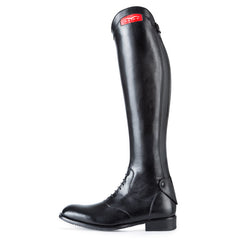Riding Boots Lasting the Distance & Buying in 2017...
By Agnieszka JR
We have been selling riding boots well pretty much since cows started eating grass, it's quite a long time ago..
We have invested in a few riding boot brands over the years, some have stuck and some have not. The one factor that always and I mean always plays a key role in the rise or demise of a horse riding boot, and that is QUALITY. Quite simply if your boots are cheaply made even with all the best marketing in the world the company will have their glory year or two and then the warranty claims will start to come thicker than the new sales and bang, the company is drowning and twelve months later its goodnight sweetheart... thanks for the memories. So, now that I have depressed everyone...lol onto the in's and out's of it all.
What I said earlier is actually true, remember those custom Konigs you bought in 2006, the ones you polished last week (in 2016) and rode out on? sadly the days of finding boots built like they used to make them are dwindling into the non existent, because the demand for a more comfortable, more technical and more aesthetically pleasing boot has exceeded the ability to produce them. We live in a time where trends are now hashtagged and become global in seconds, not even hours or days! Gangnam style was released and within 300 seconds it had already trended as a global hashtag and people were going crazy about it, an hour later and the guy was ordering his first Lamborghini. So when the "right" people start hashtagging, blogging, faecbooking, Instagramming... blah, blah, etc about a new pair of riding boots then people start to ask questions. What's this all about? "Everyone" is raving about them... and then the golden question "Where can I get a pair?"
Something I hear often from our customers is, how come my old boots I bought in 2000 are still going and this new pair I paid $1000 for only 12 months ago are starting to fall apart. The answers to this questions fall across a couple of different categories. The first is, It is your fault! Now that may sound strange but let me explain..
Remember the days when you used to buy a new pair of riding boots and it would take 3 or 4 weeks to wear them in, you would be there every night rubbing the Vaseline into the back of the heel, using a warm wet sponge on the outside of the leather.. wearing them in your house wondering around your kitchen in your nightie and pair of riding boots. I remember it well, we had to do that because the boots were pure hell, they carved up the backs of our heels like fresh ham on a sharpened cheese grater. In fact I think some of the boots I bought in the past may well have had cheese graters inside them, stitched into the back of the heel.
But, and this is the big but.. it was all worth it in the end because these boots eventually molded to your feet and only your feet and you ended up with a pair of boots that slipped over your feet like a satin glove over a royal hand. Which brings me onto one of the reasons why we now have boots that don't last because a few of us just couldn't handle wearing riding boots with our nighties anymore, they didn't want to wait 4 weeks or more for their new boots to fit them, they had no patience or acceptance of the fact that their heels would be grated for the weeks proceeding the purchase of a shiney new pair of boots and they started to whine about it. Not only did they start to complain about the boots rubbing them they also started to complain about having to pay $1500+ for a pair of custom made to measure boots. So, inevitably the manufacturers stated to look at what they could do to meet the market demand.
They needed boots which did not cost as much and did not require wearing in, and so manufacturers started to explore using calf skin for the leather uppers and mass producing them as apposed to making them by hand. Now using calf skin for the leather uppers in riding boots is absolutely fine but you also have to remember that there are over 10 different ways to tan leather. They range from using vegetable products, Formaldehyde and even the oils from animals brains.. yes, you read correctly I said animal brains but this is a rare procedure. I am not going to get into the finer details of the preparation of leather all I will say is that there are three main stages which are preparatory stages, tanning, and crusting and within these stages in particular crustings which is the process that thins, retans, and lubricates leather there are around 20 possible options including the addition of colour.
So just simply using Calf Skin will give you a soft boot of course, but the process in which the calf skin has been made and the country of origin of the leather will almost certainly determine the life expectancy of the boot.
I think and this is just my opinion, that in the pursuit to produce the most comfortable boots to meet the highest demand manufacturers have overlooked durability. Using the cheapest conditioning methods on the calf skin will reduce the final cost of the leather and also speed up the process of producing the calf skin. Using this type of conditioned calf skin for the uppers in the first place as apposed to regular cattle skin or buffalo will produce an "instant" comfort for the consumer but at what cost people?! Sure you'll slide your foot into your new boot jump up on your horse, run around the barn for a few hours and be delighted at the fact that you don't have a blister in sight, but in 8 or 12 months when your calf has worn its way through the side of your boot or the soles have peeled off how delighted are you going to be?
It is a delicate issue for the consumer, of course some wont mind replacing their $1000 boots every 12 months but most of the riders that I have spoken to aren't going to be overly happy about it.

The New K Boots from Parlanti are becoming a popular choice due to their durability and comfort, they are made from conditioned buffalo leather.
My final opinion on purchasing riding boots in 2017. Don't rush into buying a pair of boots just because they feel soft, by all means you should consider calf skin but be aware of the company that is manufacturing the boots. Where the boots are really made and the origin of the calf skin used in the boots, most retailers will provide you with this information if you ask them. If you stand the new boots up in front of you and they sag over to one side something is not right, calf skin is soft but they should stand proud and firm when new. Look at the soles of the boots, stitched and glued vibram soles are used by the best boot makers in the world and this is a sure sign of a quality finish.

Animo Zody Semi Custom Field Boots are made from the finest Italia calf skin, feedback on these boots is hugely positive. They are calf skin lined and they have glued and stitched vibram soles. These boots are made to last, 100% in Italy.
If your boots rub you when they are new then so be it, it probably means they are well made and will end up lasting you many years just get the vaseline out and rub a little on the inside of the heel and buy yourself some compeed patches. Don't going running out for a new pair of boots. Another tip for 2017 if you ride a lot of horses is to look out for boots made from Buffalo leather it is much tougher than calf skin and will last much, much longer. Once it has been worn in; Buffalo leather boots will fit your foot like a glove.

Tucci Marilyn Dress Boots, we have seen an increase in sales in the Marliyn model by Tucci in 2016, there is no denying that this Italian made boot is one of the most beautiful boots by appearance. This coupled with the use of fine Italian leather and you have a recipe for a stunning all round riding boot.
You can buy horse riding boots from Animo, Parlanti or Tucci right here.
This original article is copyrighted to Just Riding 2016.



0 comments